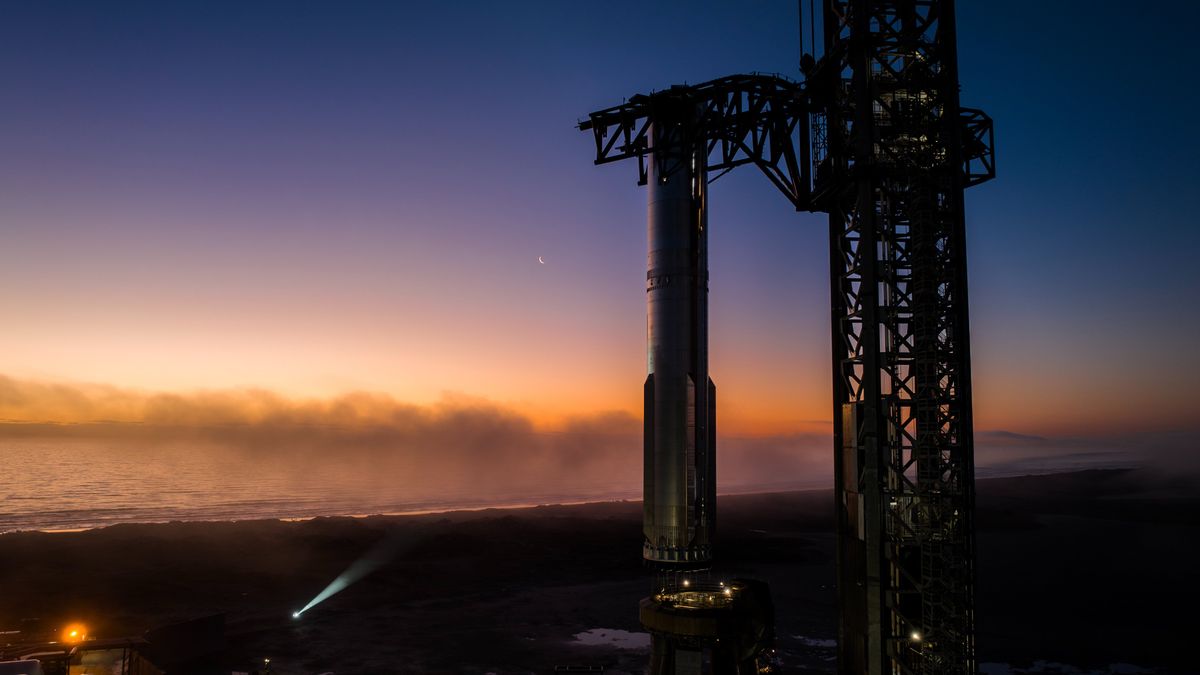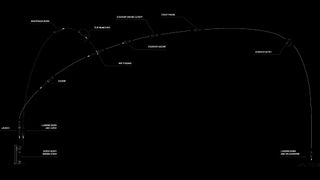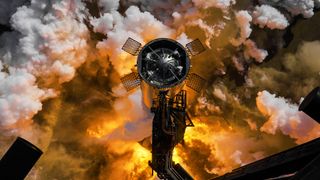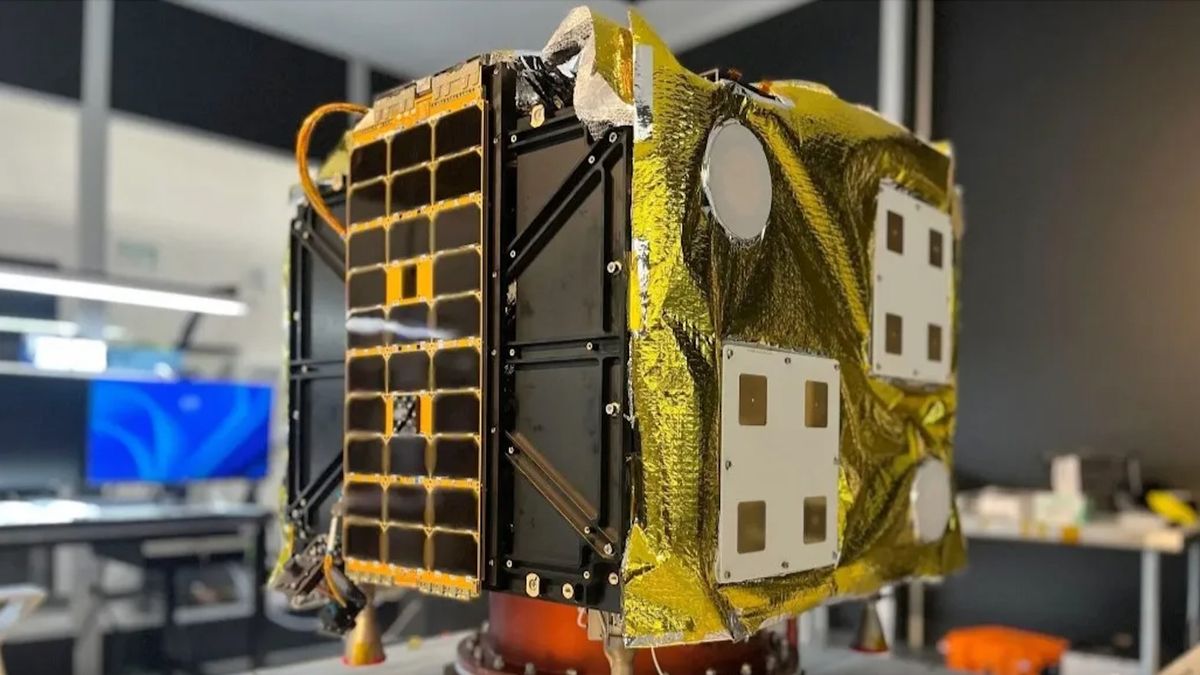
Next week, SpaceX is set to launch its newest Starship megarocket, featuring an innovative test to catch the world’s largest rocket booster using gigantic metal arms, sometimes referred to as ‘chopsticks’. If you’re eager to view this event live, we have all the information you need regarding when and how to tune in.
The Starship Flight 8 is slated to take off no earlier than Monday, March 3, at 6:30 p.m. EST (2330 GMT) from SpaceX’s Starbase facility located close to Boca Chica Beach in South Texas. As indicated by its number, this mission will represent SpaceX’s eighth test flight of the massive rocket. It follows the recent anomaly that compromised SpaceX’s Flight 7 Starship spacecraft, which succumbed to fires during ascent in January.
You can catch the live broadcast of the Starship Flight 8 launch on Space.com, thanks to SpaceX, with a livestream expected to start roughly 40 minutes before liftoff. For additional details, follow our live updates on Starship and read on for precise timing information.
When is SpaceX’s Starship Flight 8 scheduled to launch?
As it stands, SpaceX targets a 6:30 p.m. EST launch on March 3 for Starship Flight 8. Although no specific launch window has been confirmed, the previous Flight 6 test utilized a 30-minute launch window. If a similar scenario applies for Flight 8, the launch could potentially take place anytime between 6:30 p.m. and 7 p.m. EST (2330 to 0000 GMT).
It’s important to stay updated as the launch date may shift in the coming days. SpaceX had already delayed this flight once before, initially aiming for February 28, but moved it back by three additional days without specifying reasons.
SpaceX’s Starship launch system proudly holds the title of the tallest and most powerful rocket in the world. Designed for complete reusability, it towers at about 400 feet (122 meters) and consists of a massive Super Heavy booster equipped with 33 Raptor engines in its first stage, topped by a Ship upper stage featuring six Raptor vacuum engines.
The most recent Starship adventure was SpaceX’s Flight 7 test on January 16, marking the inaugural flight of an enhanced version of Starship, though the Ship vehicle was lost after a propellant leak two minutes into the ascent, resulting in debris raining over the Atlantic Ocean near the Turks and Caicos islands just over eight minutes into the flight.
Related: Check out our comprehensive guide to SpaceX Starship and Super Heavy for further insights.
The first test flight, designated Flight 1, successfully launched in April 2023, leading to SpaceX’s first venture into space, achieved with Flight 3 in March 2024. In a groundbreaking moment, SpaceX successfully caught its first Super Heavy booster with its Mechazilla metal arms during Flight 5 in October 2024, a feat that was replicated during Flight 7 last month.
How can I watch SpaceX’s Starship Flight 8 launch?

If you’re unable to travel to South Texas but don’t want to miss SpaceX’s Flight 8 launch, do not worry. You can enjoy it live online through various livestreams and webcasts covering the event. Space.com will even relay SpaceX’s livestream in real time on our site and homepage.
The broadcast of SpaceX’s Flight 8 will be available on the company’s X social media account and on its Flight 8 mission page. The livestream is expected to commence approximately 40 minutes before liftoff, at 5:50 p.m. EST (2250 GMT). This is the very feed that Space.com will also broadcast on our VideoFromSpace YouTube channel as well as on this article.
Moreover, NASASpaceflight.com will provide its own YouTube livestream, featuring 24/7 views of SpaceX’s Starship preparations and operations at Starbase.
For those close to SpaceX’s Starbase or planning to visit for the launch, several public viewing spots are available.
The public beach along South Padre Island, near the Cameron County Amphitheater and Isla Blanca Park, is an excellent option to catch the launch alongside other viewers. Additional viewing locations are along the shore of nearby Port Isabel, but please plan in advance as traffic tends to be heavy during launch times.
What is the duration of SpaceX’s Starship Flight 8?

The Starship Flight 8 test is anticipated to follow the suborbital path of the prior mission, aiming to achieve objectives that weren’t met previously, including the first payload deployment and various reentry experiments intended to ensure the upper stage’s return for capture.
According to SpaceX, the upcoming flight will also feature the launch, return, and catch of the Super Heavy booster.
If everything progresses as planned, the Super Heavy booster is expected to return to the Starbase launch pad and attempt capture by SpaceX’s Mechazilla arms around seven minutes post-liftoff. However, SpaceX has cautioned that they may decide against this capture if anything appears amiss, opting instead for a controlled splashdown in the Gulf of Mexico.
The Ship vehicle will continue its flight for about an hour, performing a payload deployment test approximately 17 minutes into the flight, followed by a demonstration of Raptor engine relight before reentering Earth’s atmosphere.
The Flight 8 Ship is projected to execute a controlled splashdown in the Indian Ocean at the one-hour and six-minute mark, likely landing somewhere west of Australia.
TIME (Hr:Min:Sec) | EVENT | Header Cell – Column 2 |
|---|---|---|
T-1:15:00 | Poll for fueling by the flight director | Row 0 – Cell 2 |
T-0:45:59 | Loading of Starship liquid oxygen begins | Row 1 – Cell 2 |
T-0:42:59 | Loading of Starship liquid methane begins | Row 2 – Cell 2 |
T-0:41:22 | Loading of Super Heavy liquid methane begins | Row 3 – Cell 2 |
T-0:35:35 | Loading of Super Heavy liquid oxygen begins | Row 4 – Cell 2 |
T-00:19:40 | Chilldown of Super Heavy Raptor engines | Row 5 – Cell 2 |
T-00:3:20 | Starship fueling completed | Row 6 – Cell 2 |
T-00:2:50 | Super Heavy fueling completed | Row 7 – Cell 2 |
T-00:0:30 | Flight Director gives the go-ahead for launch | Row 8 – Cell 2 |
T-00:00:10 | Activation of the flame deflector | Row 9 – Cell 2 |
T-00:00:03 | Starting Raptor ignition sequence | Row 10 – Cell 2 |
T-00:00:00 | Liftoff (“Excitement Guaranteed,” as SpaceX remarks) | Row 11 – Cell 2 |
TIME (Hr:Min:Sec) | FLIGHT EVENT | Header Cell – Column 2 |
|---|---|---|
T+00:02 | Liftoff | Row 0 – Cell 2 |
T+01:02 | Starship/Super Heavy reach Max Q | Row 1 – Cell 2 |
T+02:32 | Super Heavy main engine cutoff | Row 2 – Cell 2 |
T+02:40 | Hot-staging separation/Starship Raptor engine ignition | Row 3 – Cell 2 |
T+02:45 | Super Heavy boostback burn startup | Row 4 – Cell 2 |
T+03:30 | Super Heavy boostback burn engine shutdown | Row 5 – Cell 2 |
T+03:32 | Hot-stage jettison | Row 6 – Cell 2 |
T+06:37 | Super Heavy landing burn startup | Row 7 – Cell 2 |
T+06:57 | Super Heavy landing burn shutdown and catch attempt | Row 8 – Cell 2 |
T+08:44 | Starship engine cutoff | Row 9 – Cell 2 |
T+00:17:24 | Payload deployment demonstration | Row 10 – Cell 2 |
T+00:37:28 | Demonstration of Starship engine relight | Row 11 – Cell 2 |
T+00:47:22 | Starship reentry phase | Row 12 – Cell 2 |
T+01:03:05 | Starship enters transonic regime | Row 13 – Cell 2 |
T+1:04:20 | Starship becomes subsonic | Row 14 – Cell 2 |
T+1:06:04 | Starship landing flip maneuver | Row 15 – Cell 2 |
T+1:06:06 | Commencement of landing burn | Row 16 – Cell 2 |
T+1:06:26 | “An exhilarating landing!” according to SpaceX. | Row 17 – Cell 2 |
What happens if Starship can’t launch on March 3?

Should a launch of Starship Flight 8 not occur on March 3, SpaceX may have alternative options within the following days.
Cameron County officials have announced public advisories regarding road and beach closures for Boca Chica Beach on launch day, indicating that there are “alternative days” scheduled for March 4 and March 5. These closures will run from 10:30 a.m. to 11:30 p.m. local time on each of these days, allowing SpaceX the flexibility for potential launch opportunities.
SpaceX has indicated that any backup launch attempt will largely depend on progress in fueling the Starship and Super Heavy. The company has previously noted that replenishing the over 10 million pounds of supercooled liquid methane and oxygen required for launch can take several days.









